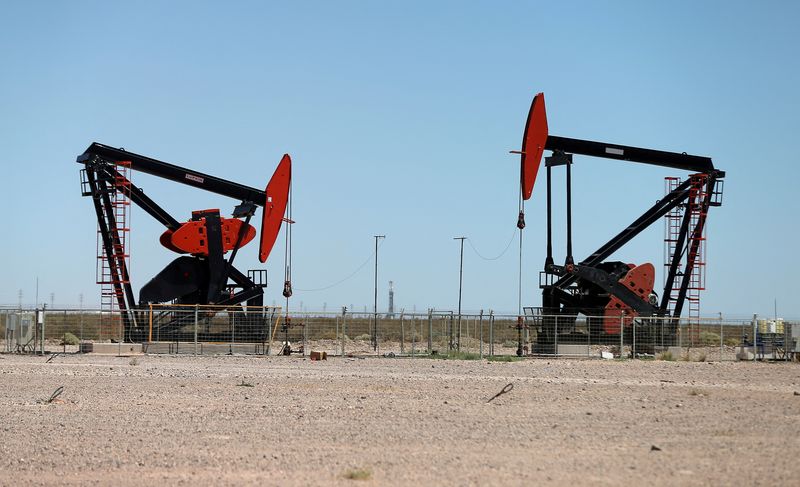Commodities
Oil prices jump on disruption fears after latest Red Sea attack


© Reuters. FILE PHOTO: The sun is seen behind a crude oil pump jack in the Permian Basin in Loving County, Texas, U.S., November 22, 2019. Picture taken November 22, 2019. REUTERS/Angus Mordant/File Photo
By Noah Browning
LONDON (Reuters) -Oil prices rose more than 2% in the first session of the New Year, boosted by potential disruption to Middle East supply after the latest attack on a container ship in the Red Sea and by Chinese demand hopes.
rose $1.72, or 2.2%, to $78.76 a barrel by 1115 GMT. U.S. West Texas Intermediate crude was up $1.57, or 2.2%, at $73.22.
A Reuters survey of economists and analysts predicted that Brent crude would average $82.56 a barrel this year, up slightly from the 2023 average of $82.17, with weak global growth expected to cap demand. Geopolitical tensions, however, could provide price support.
U.S. helicopters on Sunday repelled an attack by Iran-backed Houthi forces on a Maersk container vessel in the Red Sea, sinking three Houthi vessels and killing 10 of the militants, fuelling risks of the Israel-Hamas war becoming a wider conflict.
“The oil price may be affected by the escalation … in the Red Sea over the weekend and the peak demand season during China’s spring festival,” said Shanghai-based CMC Markets (LON:) analyst Leon Li, referring to the Lunar New Year holiday in early February.
A wider conflict could close crucial waterways for oil transportation.
At least four tankers carrying diesel and jet fuel from the Middle East and India to Europe are sailing around Africa to avoid the Red Sea, ship tracking data shows.
In China, investor expectations of fresh economic stimulus measures rose after manufacturing activity shrank for a third month in December, government data showed on Sunday.
Any such stimulus for economic growth could boost oil demand and support crude prices.
Commodities
Gold snaps five-week win streak, but bull run not over yet: MS

Investing.com — Gold snapped a five-week wining streak Friday, but the yellow metal’s bullish run likely isn’t over yet as tailwinds including central bank demand have more room to go just as the tide of outflows from gold exchange traded funds are starting to turn.
Gold prices rose 0.3% to $2,348.75, but took heavy losses earlier this week following easing Middle East tensions after Iran-Israel showed little appetite to escalate their tit-for-tat exchange.
The path ahead for gold prices is set to be choppy but likely leans toward higher highs, rather than a reversal, Morgan Staley said, forecasting the odds are more in favor of its bull case scenario, which sees gold rising to $2,760 an ounce in the second half of the year, rather than its bear case scenario of a fall to $2,000 an ounce.
The strength in the demand for the yellow metal has provided it with extra clout to withstand the weight of rising real interest rates, which have a long history of hampering investor appetite for non-interest bearing assets like gold.
Gold is typically expected to have a “negative correlation with real yields, given it loses relative competitiveness in investor portfolios as real yields rise,” Morgan Stanley said, but is now showing a positive correlation with real yields on a 3-month basis as fundamental drivers have been dominating price action.
Central bank purchases of bullion, led by People’s Bank of China, demand for safe havens amid rising geopolitical tensions, and growing demand for an inflation hedge have helped kept gold on the up, and up.
remove ads
.
These bullish factors, particularly central bank buying, aren’t likely to disappear anytime soon.
Gold consumption in China rose 5.94% from a year earlier to 308.91 tons in the first quarter of the year, China Gold Association said Friday, driven by soaring safe-haven demand.
The PBoC bullion purchases continued for a 17th straight month in March, taking its total gold reserve to 2,262.67 tons by the end of Q1, according to the China Gold Association.
Meanwhile, ETF demand has been weak throughout gold’s rally as outflows have continued, but the tide of outflows are “starting to turn,” Morgan Stanley said.
U.S. and Asia ETFs have seen inflows since mid-March, according to the World Gold Council, but that has been offset by outflows in Europe.
While these fundamental positive drivers show no sign of cooling, the macroeconomic outlook, in which U.S. inflation appears to be more sticky, keeping rates higher for longer, has some doubting gold’s next move higher.
“But if data stays strong, driving concerns of more sticky inflation, as well as elevated geopolitical risk, gold may stay well bid regardless,” Morgan Stanley said, adding that if a rate-cut is brought forward that is often another positive catalysts for gold.
Commodities
Oil settles higher on supply concerns in the Mideast, economic woes subdue gains

By Georgina McCartney
HOUSTON (Reuters) -Oil prices settled higher on Friday, garnering support from tensions in the Middle East, but a strong dollar and U.S. inflation data quashed hopes that the Federal Reserve would cut interest rates soon, giving prices a ceiling.
futures settled up 49 cents, or 0.55%, to $89.50 a barrel. U.S. West Texas Intermediate crude futures settled up 28 cents, or 0.34%, to $83.85 a barrel.
Supply concerns supported prices as tensions continue in the Middle East.
Benjamin Netanyahu, Israel’s prime minister, said any rulings by the International Criminal Court, which is investigating Hamas’ Oct. 7 attacks on Israel and Israel’s military assault on Gaza, would not affect Israel’s actions but would “set a dangerous precedent.”
As tensions escalate, Israel’s military said on Friday that its air force struck in Lebanon’s West Beqaa District and killed a militant who advanced attacks against Israel.
Israel stepped up air strikes on Rafah on Thursday after saying it would evacuate civilians from city in southern Gaza and launch an all-out assault despite allies’ warnings that doing so could cause mass casualties.
“Israel is not afraid to come and support themselves on their own if they have to, people are watching to see what happens between Netanyahu and Biden,” said Tim Snyder, chief economist at Matador Economics.
“The geopolitical element is not over, the proxy battles going on right now will continue,” and this is still providing support and helping to offset the negative pressure from the inflationary data, Snyder added.
remove ads
.
Meanwhile, macroeconomic pressures capped gains after data released on Friday showed growing inflation.
In the 12 months through March, U.S. inflation rose 2.7% after an advance of 2.5% in February. Last month’s increase was broadly in line with economists’ expectations.
The Fed has a 2% inflation target. The U.S. central bank is expected to leave rates unchanged at its policy meeting next week.
“The economic data this morning was enough for market participants to conclude that the Fed is not going to be forthcoming with interest rate cuts any time soon,” said John Kilduff, partner with Again Capital LLC.
“Geopolitical jitters in the market are what is keeping us aloft. Those two competing forces should keep us in check,” Kilduff added.
U.S. Treasury Secretary Janet Yellen told Reuters on Thursday that U.S. GDP growth for the first quarter could be revised higher, and inflation will ease after a clutch of “peculiar” factors held the economy to its weakest showing in nearly two years.
U.S. economic growth was likely stronger than suggested by the weaker quarterly data, Yellen said. Oil prices have flip-flopped since Yellen’s comments and the release of the inflation data on Friday.
Meanwhile, the dollar soared to a fresh 34-year high against the yen on Friday, bolstered in part by the U.S. inflation data.
“Dollar strength is helping to exert negative pressure today,” Kilduff said.
Elsewhere, OPEC Secretary General Haitham Al Ghais said in an op-ed article that the end of oil is not in sight, as the pace of energy demand growth means that alternatives cannot replace it at the needed scale, and the focus should be on cutting emissions not oil use.
remove ads
.
Commodities
Oil prices settle higher to snap 2-week losing streak

Investing.com– Oil prices settled higher Friday, snapping a two-week losing streak after shrugging off dollar strength following in-line inflation data at a time when geopolitical tensions persist.
At 14:30 ET (19:30 GMT), rose 0.3% to $89.85 a barrel, while rose 0.4% to $89.38 a barrel.
PCE inflation rises in line with expectations
The dollar jumped as increased 0.3% last month, taking the 12-month figure through March to 2.7%, compared with economists’ estimates for a 2.6% rise.
The PCE price index is one of the inflation measures tracked by the U.S. central bank for its 2% target.
Signs of sticky inflation in the country have resulted in investors reining in expectations that the Federal Reserve will start cutting interest rates in the near future, even after softer-than-expected U.S. data released earlier this week.
Baker Hughes rig count falls by most since November
The number of oil rigs operating in the U.S. fell to 506 from 511, according to data Friday from energy services firm Baker Hughes, marking the biggest weekly decline since November.
The fall in rig count come even as data this week showed U.S. output remained steady at near record highs.
oil production in the week ended Apr. 19, was 13.1 million barrels per day, unchanged from the prior week.
Middle East risks persist
Prices rose in recent sessions as data showed overall U.S. shrank more than expected in the past week, indicating some tightness in global oil markets.
remove ads
.
Concerns over disruptions to Middle East supplies also remained in play as Israel stepped up its strikes against Gaza. While a war with Iran did not materialize, the Israel-Hamas conflict showed few signs of stopping.
The U.S. was also set to mobilize more military aid for Israel after President Joe Biden approved a bill earlier this week.
This kept some elements of risk premium in play for oil prices, helping them weather concerns of weaker demand and softening global growth.
Still, oil prices were trading well below five-month highs hit earlier in April, as a lack of immediate escalation in the Iran-Israel conflict saw traders price out some risk premium from crude.
(Peter Nurse, Ambar Warrick contributed to this article.)

 Forex2 years ago
Forex2 years agoForex Today: the dollar is gaining strength amid gloomy sentiment at the start of the Fed’s week

 Forex2 years ago
Forex2 years agoHow is the Australian dollar doing today?

 Forex1 year ago
Forex1 year agoUnbiased review of Pocket Option broker

 Forex2 years ago
Forex2 years agoDollar to pound sterling exchange rate today: Pound plummeted to its lowest since 1985

 Cryptocurrency2 years ago
Cryptocurrency2 years agoWhat happened in the crypto market – current events today

 World2 years ago
World2 years agoWhy are modern video games an art form?

 Stock Markets2 years ago
Stock Markets2 years agoMorgan Stanley: bear market rally to continue

 Economy2 years ago
Economy2 years agoCrude oil tankers double in price due to EU anti-Russian sanctions

































